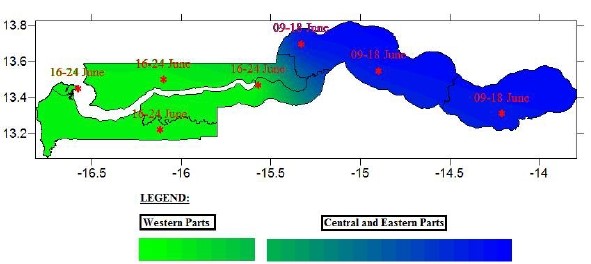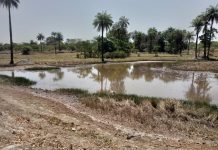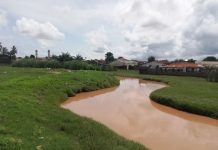with Madiba Singhateh
(Courtesy of the Department of Water Resources)
Welcome to another edition of the Environment Column and in this edition, we bring you the July-August-September (JAS) 2021 seasonal rainfall prediction from the Department of Water Resources (DWR).
But before delving into the seasonal rainfall predictions from the DWR, readers are informed that the JAS 2021 rainfall season has commenced on time as exactly predicted by the DWR report. This year’s rainfall started in the early hours of Tuesday, 9th of June 2021 at around 03.00hs and lasted for several minutes. The rains showers which have been classed as moderate by forecasters, was accompanied with lightning, thunder, but without strong winds. The downpours have affected almost all the areas of the country, with certain areas particularly the Western Region of the Gambia, receiving heavy showers and strong winds. Now we continue with the rest of the seasonal rainfall predictions for the country as provided by DWR, beginning with their introduction.
The Department of Water Resources (DWR) has issued the July-August-September (JAS) 2021 seasonal rainfall prediction, as part of its responsibility of ensuring effective monitoring of the nation’s climate and subsequent provision of the necessary weather advisories and early warnings to planners, decision-makers and operators in the various rainfall-sensitive socio-economic sectors. The sole aim of this effort is to enhance preparedness against climate hazards in the various sectors.
As in the previous years, the prediction was based on the strong tele-connection between El Nino / Southern Oscillation (ENSO) and Sea Surface Temperature (SST) anomalies over the Central Pacific Ocean (Nino 3.4 region) and Tropical North Atlantic Ocean and the rain bearing systems over The Gambia.
On the inter-annual to seasonal time scales, the variability of sea surface temperature in the equatorial Pacific (El Nino / La Nina), tropical Atlantic and Indian Oceans influence rainfall during the period July-August – September in West Africa and particularly the Sahel.
‘La Nina’ (or El Nino) conditions often coincide with the wet (dry) summer season over most of the Sahel.
When the Gulf of Guinea is warm (or cool) during April-May-June-July, it is favourable for wet conditions (or dry) over the adjacent countries.
When the tropical Atlantic is cold north of Equator and warm South of it (or warm in the north and cold in the south), it is favourable for dry conditions (or wet) in the Sahel and wet conditions (dry) over the Gulf of Guinea countries. The variations in sea surface temperature of the Indian Ocean influence rainfall over the eastern part of the Sahel (Chad, Sudan). Warming to the west of the Indian Ocean off the coast of east Africa is expected to favour a wet summer season over eastern Sahel.
JAS 2021 Rainfall Prediction:
For the coming July-August-September period, considerable variations in the amount of rainfall in the various places over the country are expected, as shown on the map below Annual rainfall amount is predicted very likely to be normal to likely below normal in the country. Most places in the country are however predicted to experience normal annual rainfall with the highest amount above 700mm expected in the western sector of the country.
Amount in the range of 600 – 650mm are likely over the rest of the country. The predicted 2021 rainfall values would therefore be normal over large areas of the country. The latest figures indicate a 25% chance of above normal rainfall, 45% chance of near-normal rainfall and 30% chance for below normal rainfall. Put in simpler terms, this means that the chance of having normal rainfall is higher than the chance of having a below normal rainfall.

Furthermore, it is worthy of note that the 2021 rainfall season is expected to undergo more variability than the 2021 season with events such as early to normal onset, late withdrawal of rains and long and medium dry spells. Accordingly, this department will undertake to provide weekly climate and short to medium range weather forecasts to better anticipate impacts of intra-seasonal climate events.
Beginning of the farming season (Onset)
In an agrarian economy like in The Gambia, where rain fed-agriculture is predominant, rainfall onset for the commencement of farming season is crucial. It affects establishment of crops, agricultural production and subsequently, national economies. Failure in the timely establishment of rainfall onset usually affects farmers. It is essential that, after a given date, the rain will become fairly continuous and sufficient to provide adequate soil moisture for and after planting is maintained as the season advances for successful establishment of crops.
The early arrival of rainfall associated with monsoon is more likely than climatology over parts of the country. In 2021, The Gambia is expected to see rainfall onset between 9th June and 18th June as illustrated in figure 2 below. These dates are expected to be generally early by up to 2 weeks over large parts of the country. Judicious use of these predictions in planning agricultural activities will lead to safe sowing and enhanced crop and food production. This information should be widely available to extension services and agencies that have the responsibility of advising farmers on appropriate time of planting and varieties to be planted.

A longer than normal length of season is predicted for most part of the country. It is expected to be in the range of 110-130 days
Long to medium dry sequences are expected at the start of the rain season in most part of the country
The Flow at the River Gambia are expected to be above normal flow
POTENTIAL SOCIO-ECONOMIC IMPLICATIONS OF 2021 SEASONAL
RAINFALL PREDICTION
Hazards Associated with 2021 Seasonal Rainfall Prediction
- Early to Near normal onset very likely over much of the country;
- Late to normal end dates;
- Dry spells during the season, and
- Above normal River flow.
For the agriculture sector:
In view of the expected average rainfall totals all over the Gambia, shorter to average dry spell durations, farmers must:
Ø Support the deployment of techniques to increase crop yields and foraging plants, through the choice of varieties of high yields crop and good seedlings and use of fertilizers (organic manure and mineral fertilizer),
Ø Strengthen the agro-hydro-meteorological supervision and assistance mechanisms for producers;
Ø Facilitate farmers access to improved seeds, in particular those with high yields that are adapted to normal to below normal rainfall.
Ø Use available water through the promotion of irrigation, recession of crops and aquaculture, in particular in flood plains.
Ø Invest in planting more seeds and exploit more arable land;
Ø Strengthen vigilance against weeds and pests (locusts and other insects).
Ø Sow early arable land;
Ø Prioritize high land areas for planting particularly areas along the River Gambia.
Disaster Management Sector
In view of the expected average rainfall totals all over the Gambia, shorter to average dry spell durations, and above-average river flows, the risk of both flash and riverine flooding is high. In order to mitigate these risks to people, animals, crops and goods, it is recommended to:
Ø Prevent the uncontrolled occupation of flood-prone areas, particularly in urban areas;
Ø Ensure the regular cleaning of the drainage channels closely monitor the alert thresholds in the various high-risk flood sites;
Ø Reinforce the flood protection dikes;
Ø Strengthen the communication of seasonal forecasts and awareness raising among vulnerable communities, by involving state actors and the various disaster risk reduction platforms in the communication and crisis management chain;
Ø Strengthen the monitoring and response capacities of agencies in charge of flood monitoring, disaster risk reduction and humanitarian aid;
Ø conduct simulation exercises as part of the preparation of flood response plans.
Regarding Phyto-sanitary and food insecurity risks:
In view of the generally wet conditions with the quantities of rain above the seasonal average in 2021 in the Central and Eastern Sahel, it is possible to observe an incursion of locust swarms’ pilgrims thanks to the early start and long dry stretches planned in the Sahelian band. This risk, associated with the situation related to COVID19 pandemic, could worsen food insecurity situations in the Sahel and West Africa. To prevent the risks, it is recommended that:
Ø States to strengthen surveillance for desert locust invasion in the risk areas of frontline countries and to maintain vigilance against other crop pests such as the fall armyworm;
Ø Inter-Governmental Organizations (IGOs) in the region to mobilize Technical and Financial Partners (TFPs) and the international community to support the country for a preventive management of phyto-sanitary risks.
Ø TFPs, to support the Sahel and West African States, the IGOs of the region in their efforts to control of crop pests and other plagues that can negatively impact agricultural production and, beyond that, the food and nutritional security of the country.
Faced with the risk of drought:
With the expected normal to below normal rainfall for the 2021 rainy season, long dry spells expected at the start of the season could delay the installation of crops and fodder biomass over most places. The water deficits can indeed lead to planting failures, affect the plant growth, promote the development of insect pests of crops, delay the return of transhumant to the North, prolong the lean season for animals and cause conflicts between breeders and farmers. To prevent these risks, it is recommended to:
Ø Diversify agricultural practices, in particular through the adoption of techniques for managing water on the plot and promoting irrigation and market gardening to reduce the risk of production in exposed areas;
ØSet up stocks of livestock feed;
Ø Prevent conflicts, by sensitizing pastoralists and farmers;
Ø Strengthening the monitoring and guidance of the movements of breeders at the search for pastures and water points;
Ø Build capacity of crop protection services to intervene in the event of outbreaks of crop pests;
Ø Ensure integrated management of water resources for a better consideration of the different uses, in particular the needs of hydro-electric dams and hydro-agricultural facilities;
Ø Farmers to interact with the technicians from Department of Water Resources, Department of Agriculture and Crop Protection Department for agro-hydro meteorological advice on what to do;
The Health Risks:
To reduce the risk of water-related diseases (Cholera, malaria, diarrhoea, etc.) in flooded areas, it is strongly recommended to:
Ø Raise awareness on climate-sensitive diseases, in collaboration with meteorological, hydrological and health services;
Ø Vaccinate people and animals, encourage the use of mosquito nets, set up stocks of medicine for curative treatments, especially in areas that will be difficult access following floods;
Ø Monitor water quality and set up stocks of treatment products;
Ø Strengthen the capacities of national health systems and disaster risk reduction platforms.
Conclusion:
A forecast is just a set of probabilities attached to a set of future events. In order to understand a forecast, all one needs to do is to interpret those bits of information. Unfortunately, there are problems in communicating each element, so that the user of a forecast understands what its producer means.
Following the consistency between the seasonal forecast probabilities and the observed rainfall that has been issued since 1998, we are recommending that the JAS seasonal forecast issued each year in the month of May to be used by policy-makers as an early warning information.
Timely climate information can lead to important decisions by producers that can dramatically increase productivity windows of opportunity.
Armed with Climate information, important decisions can be made on amounts of food to store for food reserve and excess for sale as envisaged in National Development Plan 2018 – 2021.
Pleased to inform the Cabinet and all those involved in monitoring agricultural production, that the update of the 2021 seasonal rainfall prediction will be made by Department of Water Resources at the end of June 2021.
For the information of the readership, the Department of Water Resources (DWR), has been in collaboration with sister Meteorological Services in the West African sub-region for the past twenty-three years, and have produced long range forecasts for the wet season for the whole sub-region. Their evaluation results have always indicated a reasonably high degree of accuracy, thus encouraging the release of the forecast product for the consumption of beneficiary countries. And as in previous years, this year’s prediction is based on the strong tele-connection between El Nino/ Southern Oscillation (ENSO) and Sea Surface Temperature (SST) anomalies over the Central Pacific Ocean (Nino 3.4 region) and Tropical North Atlantic Ocean and rain bearing systems over The Gambia, as indicated earlier.




















